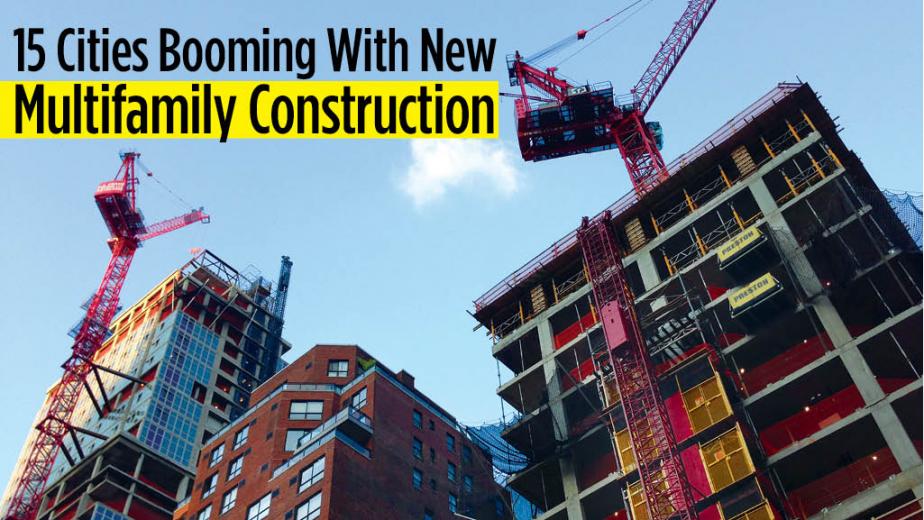1 16
1 16
Considering there is historically high demand for rental properties, coupled with limited supply, it's no wonder multifamily construction is up this year. New multifamily construction is at a 10-year high, according to Internet listing service RentCafe and sister company Yardi Matrix, which are projecting a 50 percent increase year-over-year in apartment construction for 2016, with 320,000 new apartments to be completed.
What unit sizes are developers favoring? This year, 51 percent of new apartments will be one-bedrooms. Of the remainder, two-bedrooms will comprise 37.5 percent, three-bedrooms will represent 6.7 percent and studios will make up the smallest share, at 4.7 percent of national rental inventory.
As supply increases, pricing has begun to moderate. National rental rates are projected to increase just 4.4 percent by year-end, after peaking in 2014 with 6.3 percent growth. (In 2015, rents grew by 5.6 percent.)
A workstation in Boston costs $10,995 per year, with the city coming in as the fifth most expensive in the U.S. and 15th most expensive globally.
Chicago metro got a weighted score of 40.1 when all of the relevant factors were considered. The city and surrounding suburbs have 8.9 million sq. ft. of life sciences space, with a current vacancy rate of 4.6 percent and average asking rents of $10.97 per sq. ft.
Phoenix’s multifamily market will see added supply of 8,597 new apartment units this year.
One example is ASU’s 42-acre Scottsdale Innovation Center, projected to produce more than $32 billion in economic output and 10,000 new jobs in the next 30 years.
“The huge investments in retail, office and industrial projects in the Phoenix metro have translated into more jobs and increased demand for housing, which in turn favor multifamily construction,” says Rent Café analyst Ama Otet.
Time will tell if 2016 is the year that supply catches up to demand in San Francisco. New multifamily construction will bring 9,362 units to the rental market here – a 126 percent year-over-year increase in completions, according to Rent Café data.
Approximately 10,421 new apartment units will come on-line here this year.
Denver keeps booming. The city’s multifamily supply will see the addition of 10,849 units in 2016.
“Employment is strong in the Denver area, mainly supported by job gains in the technology, healthcare, business and hospitality sectors,” Otet says. “Also noteworthy, the booming cannabis industry is frequently cited as a catalyst for consistent job growth.”
The city’s healthy job market includes employers such as Lockheed Martin, United Airlines, UCHealth, Charles Schwab, Google, Ibotta and SendGrid.
Georgia’s state capital, Atlanta, is seventh, with 8,691 planned units. Again, Atlanta represents a market with a potential slowdown, as there are 24,276 units under construction currently—the fifth-highest amount in the nation. However, it is possible that more units will be planned soon, as it the permitting takes less time in Atlanta compared to some other cities.
“Occupancy is particularly high in the area (96 percent), with Downtown Miami and South Beach standing as the most popular renting hotspots in the city,” Otet says.
By the end of 2016, the Miami multifamily market will see an additional 13,245 units, despite high occupancy rates. This figure represents a 30 percent year-over-year increase.
Tech industry workers are moving to Seattle in increasing numbers and developers are trying to capitalize on this newfound demand. By the end of 2016, 13,384 new multifamily units will be completed here.
Multifamily construction will result in 13,568 new apartment units added to the Austin market in 2016.
Developers will bring 18,027 new multifamily units to Washington, D.C. in 2016, a 30 percent increase from the year before. The area is known as being strong in employment; it was reported earlier this year that 8.7 percent of Millennials living in nearby Arlington, Va. make more than $350,000 per year.
By the end of this year, new multifamily construction will total 20,205 apartment units here.
Dallas come in second for new multifamily construction, with 23,159 apartment units added in 2016. The city’s rental rates are expected to rise 3.7 percent this year, according to RentCafé.
With the second busiest port in the nation and a diversified economy, Houston has built more industrial space over the last decade than any other U.S. city, according to the Houston Chronicle, including 8.59 million sq. ft. since 2012. With industrial vacancy at 5.4 percent, asking rents are at $5.80 per sq. ft.

